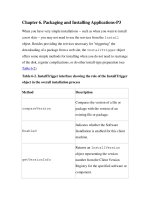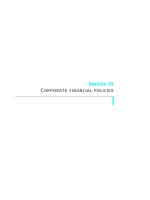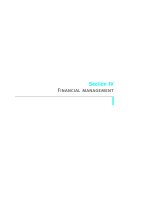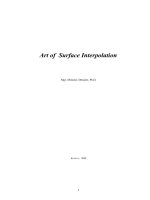Tài Liệu Lecture Human Resource Acquiring Chapter 1 Introduction To Human Resource Acquiring.pdf
Bạn đang xem bản rút gọn của tài liệu. Xem và tải ngay bản đầy đủ của tài liệu tại đây (896.18 KB, 34 trang )
04/08/2021
HUMAN RESOURCE
ACQUIRING
ThS. Nguyễn Đức Nhân - Bộ môn Quản trị nhân lực
Khoa Kinh tế và Quản lý nguồn nhân lực
1
2
LECTURER’S INFORMATION
• Fullname: MBA. Nguyễn Đức Nhân
• Addess: Building A1, Room 606, National Economics University 227 Giai Phong, HBT, HN
• Faculty/ Institute: Faculty of Human Resource Economics and Management
• Website: />• Mobile: 0934 552 220
• Email: /
4-Aug-21
2
1
04/08/2021
3
GENERAL INFORMATION
• Title: HUMAN RESOURCE ACQUIRING
• Course number: NLQT1117
• General Education courses
• Units: 3 credits
• Theoretical hours: 25
• Practical hours: 20
• Prerequisite: Management, Human Resource Management
4-Aug-21
3
4
LEARNING RESOURCES
• Course book:
• Henneman III H., Judge T. and Kammeyer – Muller J. (2019), Staffing
Organizations, McGraw-Hill, 9th edition, ISBN 978-1-259-75655-9
4-Aug-21
4
2
04/08/2021
5
REFERENCE BOOKS
• Philips J. & Gully S. (2015), Strategic Staffing, 3rd Edition, ISBN 978-0-13-357176-9
• Pilbeam S. & Corbridge M. (2010), People Resourcing and Talent Planning HRM in practice, 4th edition
Pearson Education Limited, ISBN 978-0-273-71954-0
• Dessler G. (2013), Human Resource Management, 13th edition, Prentice Hall, ISBN: 978-0-13-266821-7
• Amstrong M. (2009), Amstrong’s Handbook of Human Resource Management Practice, 11th edition,
Kogan Page Limited, ISBN 978 0 7494 5242 1
• Nguyen Ngoc Quan, Nguyen Van Diem, (2013), Quản trị nhân lực, Publishing House of National
Economics University, Hanoi.
4-Aug-21
5
6
ACTIVITY
What functions does HRM normally include?
4-Aug-21
3
6
04/08/2021
11
COURSE DESCRIPTIONS
• This course is to provide students with knowledge and skills of selecting and placing right people into
right positions at right time through implementing recruitment and selection, orientation and staffing
for organizations.
• Main topics will be covered as follows:
• Chapter 1: Introduction to human resource acquiring
• Chapter 2: Recruitment
• Chapter 3: Selection
• Chapter 4: Staffing
4-Aug-21
11
• Understand the concepts, the importance, the requirements, the
process, and the methods of recruitment, selection as well as the
roles, responsibilities and authorities of the human resource
COURSE
GOALS
department
in
human
resource
acquisition
within
the
organization.
• Understand the concepts, the significance, the objectives, the
process, and the methods of orientation and socialization of new
employees as well as internal staffing functions of human
resource management practice.
4-Aug-21
20
20
4
04/08/2021
21
CHAPTER 1: INTRODUCTION TO
HUMAN RESOURCE ACQUIRING
• 1.1. The concept and implications of Human Resource Acquiring
• 1.1.1. Concept
• 1.1.2. The implications of Human Resource Acquiring
• 1.1.3. Components of Human Resource Acquiring system
• 1.1.4. Integrating the functional areas of human resource management
• 1.1.5. Roles and responsibilities of Human resource Department
• 1.2. Bases of Human Resource Acquiring
• 1.2.1. Job analysis
• 1.2.2. Human resource planning
• 1.2.3. Business and Staffing strategy
4-Aug-21
21
22
CHAPTER 2: RECRUITMENT
• 2.1. The role of recruitment
• 2.1.1. Concept
• 2.1.2. The importance of recruitment
• 2.1.3. Factors influence recruitment process
• 2.2. The sources and methods of recruitment
• 2.2.1. Sources and methods of internal recruitment
• 2.2.2. Sources and methods of external recruitment
• 2.3. The recruitment process
• 2.3.1. The role of human resources department
• 2.3.2. Steps of implementation
• 2.4. Recruitment process evaluation
• 2.4.1. The costs of recruitment
• 2.4.2. The quality of recruitment
4-Aug-21
22
5
04/08/2021
23
CHAPTER 3: SELECTION
• 3.1.The role of selection
• 3.1.1. Concept
• 3.1.2. The importance of selection
• 3.1.3. The requirements of selection
• 3.2. The selection process
• 3.2.1. Responsibilities of the parties involved in selection
• 3.2.2. Steps of implementation
• 3.3. Design and implementation of selection tests and
interview
• 3.3.1. Designing and implementing test
• 3.3.2. Designing and conducting interview
• 3.4. Evaluating selection process
• 3.4.1. Selection costs
• 3.4.2. Selection quality
4-Aug-21
23
24
CHAPTER 4: INTERNAL STAFFING
• 4.1 Orientation
• 4.1.1.Concept
• 4.1.2. Contents of an orientation program
• 4.1.3. The orientation process
• 4.2. The internal staffing process
• 4.2.1. Transfer
• 4.2.2. Promotion
• 4.2.3. Demotion
• 4.3. Termination
• 4.3.1. Layoff
• 4.3.2. Dismissing
• 4.3.3. Resignation
4-Aug-21
24
6
04/08/2021
25
COURSE ASSESSMENT
• Class Participation: 10% (Attendance points & Times of answers and
questions in class)
• Midterm exam (Individual work): 20%
• Group Project: 20%
• Final Exam: 50%
• Requirement: attend more than 80% of the total classes and hand in
both mid-term exam and group assignment on time
4-Aug-21
25
• You should work individually.
• You will need to research an actual company and learn how HRM is
done in industry.
• Each student will be scheduled one day for an individual
Midterm exam
(Individual work)
– 20%A
presentation. There are no opportunities to makeup a missed
presentation so you should avoid missing it for any reason.
• In this presentation, you will present your research findings about
how one company performs their hiring process.
OR
• Failure to present on time could be substituted by writing a brief
report about how one company performs their hiring process, but
with lower grades at least 2 points.
4-Aug-21
26
26
7
04/08/2021
27
Midterm exam (Individual work) –
20%A
Introduction tasks:
• 1. Introduce yourself (name, ID on slides).
• 2. Name the company you will research.
• 3. How was this company chosen (one sentence)?
Presentation tasks:
• 1. What are the different ways a company can do recruitment and selection?
• 2. What are the strengths and weaknesses of each way?
• 3. Critically evaluate the strengths and weakness of the company’s hiring
practices.
• 4. Compose and answer a question which you think is most relevant to this firm’s
HRM practice.
4-Aug-21
27
28
Presentation – 20%
• General grading guidelines: Descriptive = Pass; Evaluation and Analysis =
Merit; Critical Evaluation, Synthesis = Distinction
• Slides must contain very clear evidence of your analysis, evaluation, etc. along
with full references to the journal articles you used to support your points (do
not use general public websites as they are unreliable).
• You must submit a copy of your slides (in the original format) to LMS. The first
slide should contain your name, student ID, and the name of the company you
are researching.
• Your presentation should be very detailed. Simple answers show little
understanding, which will lower your grade.
• You will have a limit of 5 minutes. There may also be questions after.
• Because time will be tight, going over the time limit will lower your grade.
4-Aug-21
28
8
04/08/2021
29
Report – 20%
• General grading guidelines: Descriptive = Pass; Evaluation and Analysis =
Merit; Critical Evaluation, Synthesis = Distinction
• Your report must contain very clear evidence of your analysis, evaluation,
etc. along with full references to the journal articles you used to support
your points (do not use general public websites as they are unreliable).
• You must submit a soft copy (no hard copy) of your report (in the Word
format) to LMS.
• Your report should be very detailed. Simple answers show little
understanding, which will lower your grade.
• Your report should be 600 words in length (+/- 150 words). Failing to
comply with this limit will lower your grade.
4-Aug-21
29
30
COMPANY REGISTRY
• Each student must choose a unique company and the company must have operations (with at least 50
employees) in Vietnam. The first student to register their company gets that company. If a student chooses
more than one company, only their most recent company counts.
• Note: Please consider which company you would like to research. It should be a company that you have
access to (for example, if a relative works there) or one that you are very interested in (for example, a
company you would like to work for one day). Generally, any company is fine as long as it has at least 50
employees. However, please avoid using government agencies. You can use State Owned Enterprises (like
Agribank), just not government offices (like the State Bank of Vietnam). If a company is large, like
VinGroup, you should choose a smaller unit within that company, for example, VinFast or VinSchool.
04-Aug-21
30
9
04/08/2021
32
Group Project (Interview role-play) –
20% B
• The Group project is an analysis of a topic assigned by teacher.
• Class is divided into groups. Each group has from 3 to 5 members. Groups will be decided by the 1st class.
• You can use your research into your company but you will not be reporting anything. Your team will act out a
hiring process, focusing on the interview (but you can also include other aspects which you feel are relevant).
• You can divide your team anyway you think best to illustrate which techniques you understand well in an
interview.
• You will need at least one interviewer and at least one interviewee (candidate).
4-Aug-21
32
33
INTERVIEW ROLE-PLAY ASSESSMENTS
• Your grade will be driven by how much you show you understand
about the selection process.
Grading: Simple illustration = Pass; Complex
understanding = Merit; Creative and
realistically complex = Distinction.
• Interviewing is just one part of the selection process. You should also
consider shortlisting, practical job tasks, intelligence and other tests.
• You will have a maximum of 10 minutes (it can be shorter) for your
role play. There may be questions from the audience after.
• You should submit one paper which includes the names, IDs, and
role for each member. This paper should also include a brief
explanation of the story of the role play. You should email a page in
Word (.docx) format listing the subject of your role-play and which
student performed which role are relevant).
4-Aug-21
33
10
04/08/2021
34
• Times of answers and questions in class.
• Positive contribution in class and compliance
with the class rules.
4-Aug-21
34
35
QUESTIONS?
4-Aug-21
11
35
04/08/2021
36
TIMELINE
Week 1
Introduction to Human Resource Acquiring
Week 2
The Sources and Methods of Recruitment
Week 3
The Recruitment Processes
Week 4
The Selection Processes
Week 5
Selection Tests
Week 6
Selection Interview
Week 7
Guest Speaker
Week 8
Presentation 2.1
Week 9
Presentation 2.2
Week 10 Presentation 2.3
Week 11 Orientation
Week 12 Revision
4-AUG-21
36
CHAPTER 1: INTRODUCTION TO
HUMAN RESOURCE ACQUIRING
ThS. Nguyễn Đức Nhân - Bộ môn Quản trị nhân lực
Khoa Kinh tế và Quản lý nguồn nhân lực
4-Aug-21
12
37
04/08/2021
38
CONTETNS
• 1.1. The concept and implications of Human Resource Acquiring
•
•
•
•
•
1.1.1. Concepts
1.1.2. The implications of Human Resource Acquiring
1.1.3. Components of Human Resource Acquiring system
1.1.4. Integrating the functional areas of human resource management
1.1.5. Roles and responsibilities of Human resource Department
• 1.2. Bases of Human Resource Acquiring
• 1.2.1. Job analysis
• 1.2.2. Human resource planning
• 1.2.3. Business and Staffing strategy
04-Aug-21
38
39
THE BIG PICTURE
• Organizations are combinations of physical, financial, and human capital
• Human capital
• Knowledge, skills and abilities of people
• Their motivation to do the job
• Scope of human capital
• An average organization’s employee cost (wages or salaries and benefits) is over 25% of its total
revenue
• Organizations that capitalize on human capital have a strategic advantage over their competitors
04-Aug-21
39
13
04/08/2021
40
CONCEPTS
• Staffing is the process of acquiring, deploying, and retaining a workforce of sufficient
quantity and quality to create positive impacts on the organization’s effectiveness.
• Acquistion activities involve external staffing systems that govern the initial intake of applicants into
the organization.
• Deployment: the movement of current employees throughout the organization through internal
staffing that handle promotions, transfers, and new project assignments.
• Retention: organization should try to minimize the turnover and retain the valued employees
4-Aug-21
40
41
THE IMPLICATIONS OF HUMAN
RESOURCE ACQUIRING (1)
Acquisition activities involve
• planning for the numbers and types of people needed,
• establishing job requirements in the form of the qualifications or knowledge, skills, abilities,
and other characteristics (KSAOs) needed to perform the job effectively,
• establishing the types of rewards the job will provide,
• conducting external recruitment campaigns,
• using selection tools to evaluate the KSAOs that applicants possess,
• deciding which applicants are the most qualified and will receive job offers,
• and putting together job offers that applicants will hopefully accept.
04-Aug-21
41
14
04/08/2021
42
THE IMPLICATIONS OF HUMAN
RESOURCE ACQUIRING (2)
• Deployment refers to the placement of new hires in the actual jobs they will hold, something that may
not be entirely clear at the time of hire, such as the specific work unit or geographic location.
• Deployment also encompasses guiding the movement of current employees throughout the
organization through internal staffing systems that handle promotions, transfers, and new project
assignments.
• Internal staffing systems mimic external staffing systems in many respects, such as planning for
promotion and transfer vacancies, establishing job requirements and job rewards, recruiting
employees for promotion or transfer opportunities, evaluating employees’ qualifications, and making
job offers to employees for new positions.
04-Aug-21
42
43
THE IMPLICATIONS OF HUMAN
RESOURCE ACQUIRING (3)
• Retention systems seek to manage the inevitable flow of employees out of the organization.
• Sometimes these outflows are involuntary on the part of the employee, such as through layoffs or the sale
of a business unit to another organization.
• Other outflows are voluntary in that they are initiated by the employee, such as leaving the organization to
take another job (a potentially avoidable turnover by the organization) or leaving to follow one’s spouse or
partner to a new geographic location (a potentially unavoidable turnover).
• It should try to minimize the types of turnover in which valued employees leave for greener pastures
elsewhere—namely, voluntary-avoidable turnover. Through various retention strategies and tactics, the
organization can combat these types of turnover, seeking to retain those employees it thinks it cannot afford
to lose.
04-Aug-21
43
15
04/08/2021
44
STAFFING
ORGANIZATIONS
04-Aug-21
44
45
ORGANIZATION’S GOALS
• An organization is a combination of: Physical, Financial & Human Capital
• Organizational Strategy
• Profitability, market share, customer satisfaction and environmental stability
• HR Strategy:
• Acquires, deploys, and retains
• Human Capital refers to: Knowledge, skills, and ability of its people!
• “How do we hire the right people?”
04-Aug-21
45
16
04/08/2021
46
HIRING OBJECTIVES
• What would be the potential problems with a staffing process in which
vacancies were filled:
• On a lottery basis from among job applicants?
• On a first come-first hired basis?
• What would be the advantages of using one of the staffing processes?
04-Aug-21
46
47
STAFFING/ACQUIRING
• is an important managerial function.
• is a pervasive activity.
• is a continuous activity.
• The basis of staffing function is efficient management of personnel.
• helps in placing right men at the right job.
• is performed by all managers .
04-Aug-21
47
17
04/08/2021
48
STAFFING MODELS
• Staffing Quantity: Levels
• Staffing Quality: Person/Job Match
• Staffing Quality: Person/Organization Match
04-Aug-21
48
49
STAFFING QUANTITY LEVELS
Head count requirement vs. Workforce available
Considering quantity but not quality
The simplest model
04-Aug-21
49
18
04/08/2021
50
STAFFING QUANTITY LEVELS
• The organization as a whole, as well as each of its units, forecasts
workforce quantity requirements and then compares these forecasted
with workforce availabilities to determine the staffing level position.
04-Aug-21
50
51
STAFFING QUALITY:
PERSON/JOB MATCH
04-Aug-21
51
19
04/08/2021
52
CONCEPTS: PERSON/JOB MATCH MODEL
• Jobs are characterized by their requirements and rewards
• Individuals are characterized via qualifications (KSAOS) and motivation
• These concepts are not new or faddish,
this is an enduring model of staffing
• Matching process involves dual match
• KSAOs to requirements
• Motivation to rewards
• Job requirements expressed in terms of
both
• Tasks involved
• KSAOs necessary for performance of
tasks
• Job requirements often extend beyond
task and KSAO requirements
04-Aug-21
52
53
STAFFING
QUALITY:
PERSON/
ORGANIZATION
MATCH
04-Aug-21
53
20









